Article's Content
A picture is worth a thousand words and, as of January 2022, a whiteboard is worth $17.5 billion. Well, one specific online collaborative whiteboard platform to be exact: Miro.
Given how many billion-dollar companies and earth-shattering ideas begin as scribbles on a flat surface, it’s no surprise that the collaborative whiteboard market is taking off.
The pandemic fast-tracked the transition to remote and hybrid organizations, meaning companies need tools that support visual ideation across space and time. From rocket scientists calculating the trajectory of Apollo 13 on a chalkboard to Mark Zuckerberg and Eduardo Saverin jotting down algorithms on a dorm-room window to the head coach drawing up a new play on their clipboard, the allure of a “blank canvas” applies just as much to technicians as it does to artists.
This makes sense. We’re a visual species.
In fact, more than 50% of the human cortex is involved in processing information visually. Pair that with the maxim of the “social creature” and you begin to see why Miro is leading the charge. Their product is only limited by the extent of a team’s imagination.
Miro’s impressive resume tells you everything you need to know about the growing demand for digital collaboration:
- A $17.5-billion valuation as of January 2022.
- One of the top 20 most valuable private companies across the globe.
- A global network of 35 million users and 130,000 clients.
- 100+ app integrations with platforms like Atlassian, Cisco Webex, Google Workplace, Microsoft Teams, and Zoom.
Thanks to their product and content excellence, a masterful rebranding campaign, and empowering a global community of users, Miro is perfectly positioned to live out its founder’s dream of “Powering Co-Creation for a New Era” with its cloud content collaboration software.
Before we get into it, let’s take a brief look at why this particular SaaS tool is so important.
The New Roaring ‘20s Are Hybrid-Remote
In striking similarity to the first Roaring ’20s, the 21st-century edition was also jarred by a global pandemic and its economic fallout. Like today, those trying times also sparked incredible innovation, paradigm shifts, and economic opportunity. The biggest, by far, is the rise of hybrid-remote organizations.
According to the American Community Survey, just 6% of people worked primarily from home before the pandemic, an increase of about 2% from 2009-2020. Before March 2020, the ethos of commuting to work was still quite strong. At the height of the pandemic, the number of people working primarily from home skyrocketed to over 70%.
In our current state of relative stability, some companies are choosing to put butts back in seats, but the pandemic has left a lasting impact at the organizational level. Companies across all industries, but SaaS in particular, are deciding to adopt either a fully remote or remote-hybrid structure.
Unfortunately, companies also find that this structure isn’t all sunshine and rainbows. There are organizational and individual drawbacks to the remote work movement:
- A 250% increase in the amount of time spent in meetings each week
- 60% of employees experiencing a decrease in engagement
- An increase in the description of workplace relationships as “transactional”
- An increase in feelings of loneliness and isolation for remote team members
- 11 straight months of 4+ million resignations
Miro calls this predicament the hybrid “worst of both worlds.” It’s a newly divided workforce that is driving the great resignation far beyond the point of being a pandemic overreaction. People want remote work and remote support, but they also want connection.
In their most recent keynote, the Miro team outlines what they see as the five key ingredients of a successful hybrid-remote workspace:


Image source: Miro Next 2022 keynote
In short: Visual collaboration is the cornerstone of the hybrid workstack.
Whiteboards Go Digital
You’ve heard us talk before about how a huge percentage of the B2B SaaS market is indebted to the unbundling of Excel. Several billion-dollar software niches—think project management, accounting, scheduling, and sales—are essentially built on the formula of spreadsheet + enhanced UX/UI + branding. It’s a mind-boggling realization.
Excel brought spreadsheets into the online world nearly 40 years ago to the delight of the analytically and organizationally inclined, setting the stage for today’s booming SaaS industry. It’s only in the last decade or so that creative teams have experienced a similar transition for their favorite tool:
The digitalization of the whiteboard.
In the early 2010s, prominent visual collaboration tools like Miro, LucidSpark, Mural, InVision, and Creately all jumped on the scene, each offering teams the ability to collaborate outside the confines of spreadsheets, physical offices, and even time. If there were any doubts about the value of these digital whiteboards before the pandemic, they’ve since been erased.
Just take a look at the search data for “online whiteboard” over the past 5 years:


And now the interest in “Miro whiteboard” over the same period of time:


Miro’s success is emblematic of this greater societal shift, with its user count growing over 600% from 2020 to 2022. So, the question isn’t why are collaborative whiteboards so popular, but why are Miro Boards, in particular, so popular?
Let’s find out.
How Miro is Winning the Collaborative Whiteboard Market
Miro is the undisputed SaaS leader in the collaborative whiteboard space. They boast a total user base of 35 million people, service 99% of the Fortune 100, and are currently the highest-ranked visual collaboration tool on G2. Quite the resume.
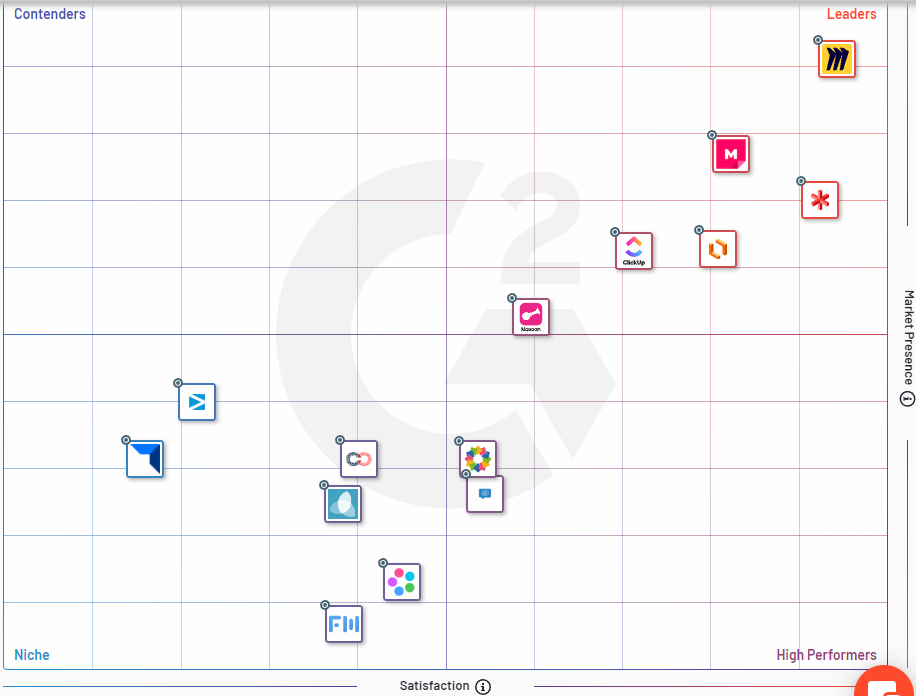

Image source: G2 Visual Collaboration Grid
The road from humble startup to SaaS powerhouse is paved by product superiority, we all know that by now. Boot-strapping is in every growth playbook, meaning even the newest niches are quickly saturated with agile competitors. The collaborative whiteboard niche is no exception. With marketing case studies like this, it’s easy to gloss over the herculean effort behind creating a successful MVP and finding product-market fit.
But in order to sustain that growth and reach the vaunted unicorn status, B2B SaaS brands need the marketing keys of content, brand, and community excellence.
Here’s how Miro leveraged their superior product to win these three key marketing categories to achieve the high level of success they have today.
1st Key: Extending Product Excellence Into Organic Content
Product excellence is a necessity, no doubt. That said, there’s a limit to how far a SaaS product can take your company in terms of growth.
The collaborative whiteboard market exhibits this perfectly. Just take a quick look at the thin margin separating Miro from some of its main competitors on the end-user level:
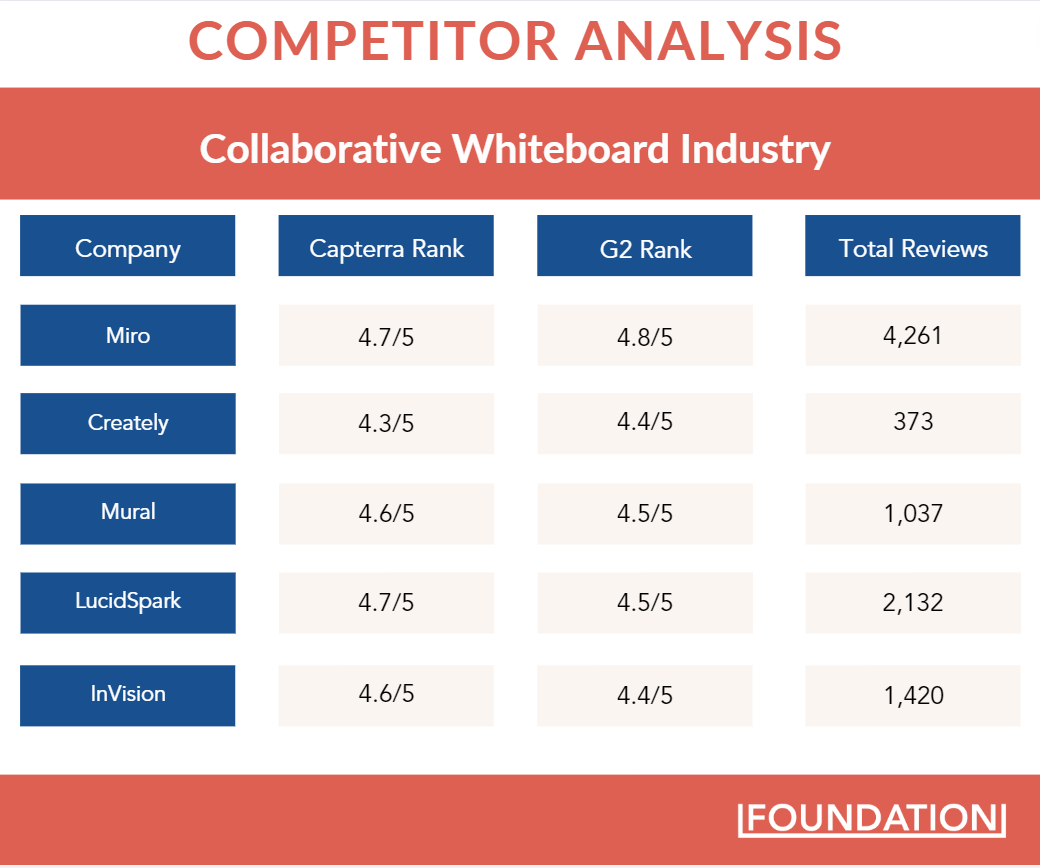

From the perspective of a potential user vetting different collaborative whiteboard products, there’s not a whole lot separating Miro from Creately, Mural, LucidSpark, and InVision. This is because the products offer core features that service similar use cases, mainly online whiteboards for:
- Creative ideation and brainstorming
- Remote-hybrid workshops and meetings
- Concept map and diagram creation
- Agile project management
- Product design
- Flowcharting
- User experience and design
- Tech stack integrations
Given the varying contexts that visual collaboration occurs within, Miro and the rest of the industry need to find numerous ways to extend their product excellence into the realm of strategic partnerships and content. Let’s start with the former.
One way to be sure a B2B SaaS company is conquering the market is through the number of integrations they offer. It’s a shoutout from big players in other SaaS verticals who acknowledge that the product in question is not only here to stay, but is also able to increase the value of their own offering. If Miro was a musician, they’d almost certainly have a Grammy for best feature. They’ve got over 100 SaaS tool collaborations attesting to that fact.
Name a tech-stack segment and Miro responds with a host of apps and integrations that connect with top SaaS tools to improve collaboration within that particular niche.


Product management? Miro integrates with Teams, Slack, Airtable, and Notion.
Research and design? Connect Miro with Figma, Adobe, InVision, and Box.
Software engineering? Azure, Trello, GitHub, and Jira are all on the table.
But product integrations alone don’t get you the satisfied end-users who will expand their product use, become enamored with your brand, and ultimately join your product community. The Miro team knows that content excellence is a necessary part of the growth process.
This is where UX-centered content like template pages come into play.
Convert product excellence to content excellence with user-friendly templates
In the same way that technical SaaS brands like MongoDB and HashiCorp view API documentation as an extension of their IT products, creative software companies can leverage content to spark creativity and improve the overall product experience.
It’s a playbook we’ve seen work well with companies like Notion and ClickUp: providing users with templates that immediately improve the experience and consistently expand a product’s use-case horizon.
Here’s how 5 top collaborative whiteboard companies stack up in terms of their template galleries:
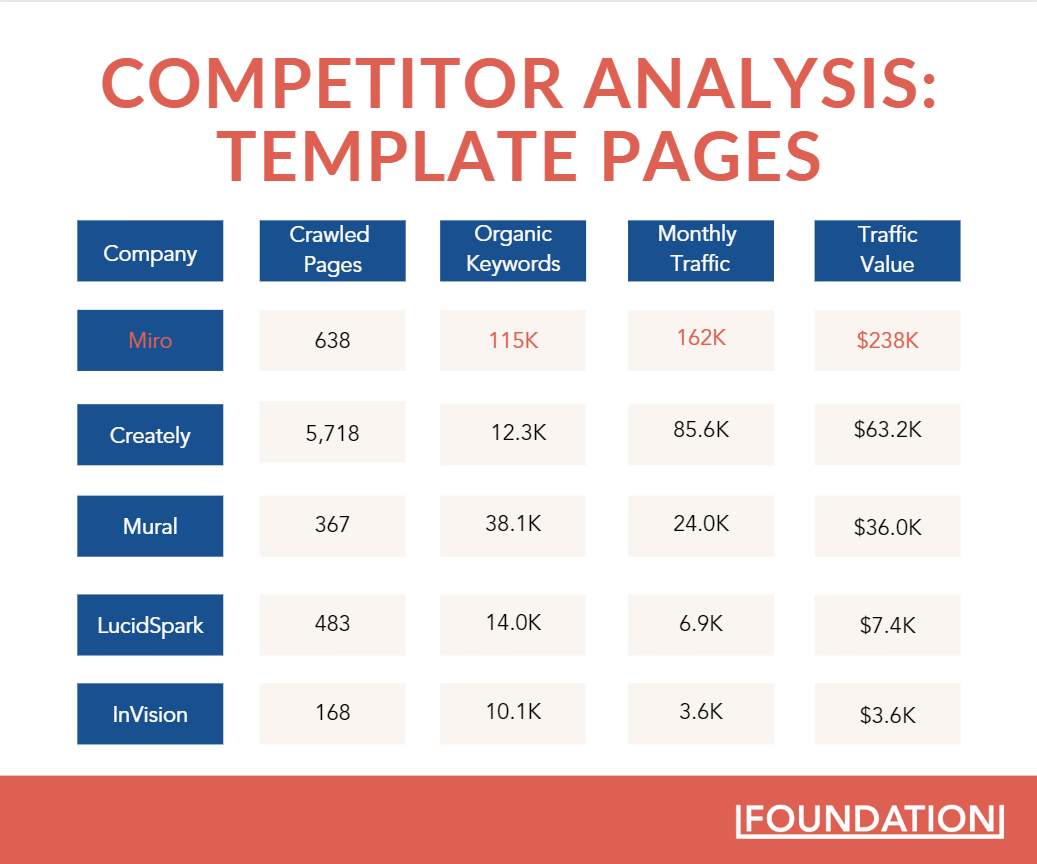

Miro takes a quality over quantity approach to templating and it’s clearly paying dividends. Their subfolder provides more organic traffic than the rest of their competitors combined, at a higher overall traffic value to boot. This resource hub is a big part of Miro’s overall success in terms of organic marketing.
The Miro website sees about 1.7M in monthly organic traffic, valued at $828K, across 23K pages. Blog posts, product pages, detailed use cases (broken down by both team and situation), help centers, enterprise resources, pricing pages, and thousands of other sources of rich content are housed within the Miro domain. And remember, only 638 of those are templates created by Miro directly.
In other words, of the thousands upon thousands of pages they create, 2.77% of these pages are driving 29% of the traffic value. But this is a visual collaboration tool, so let’s take a look at what visitors see when they stumble upon one of these high-value templates:
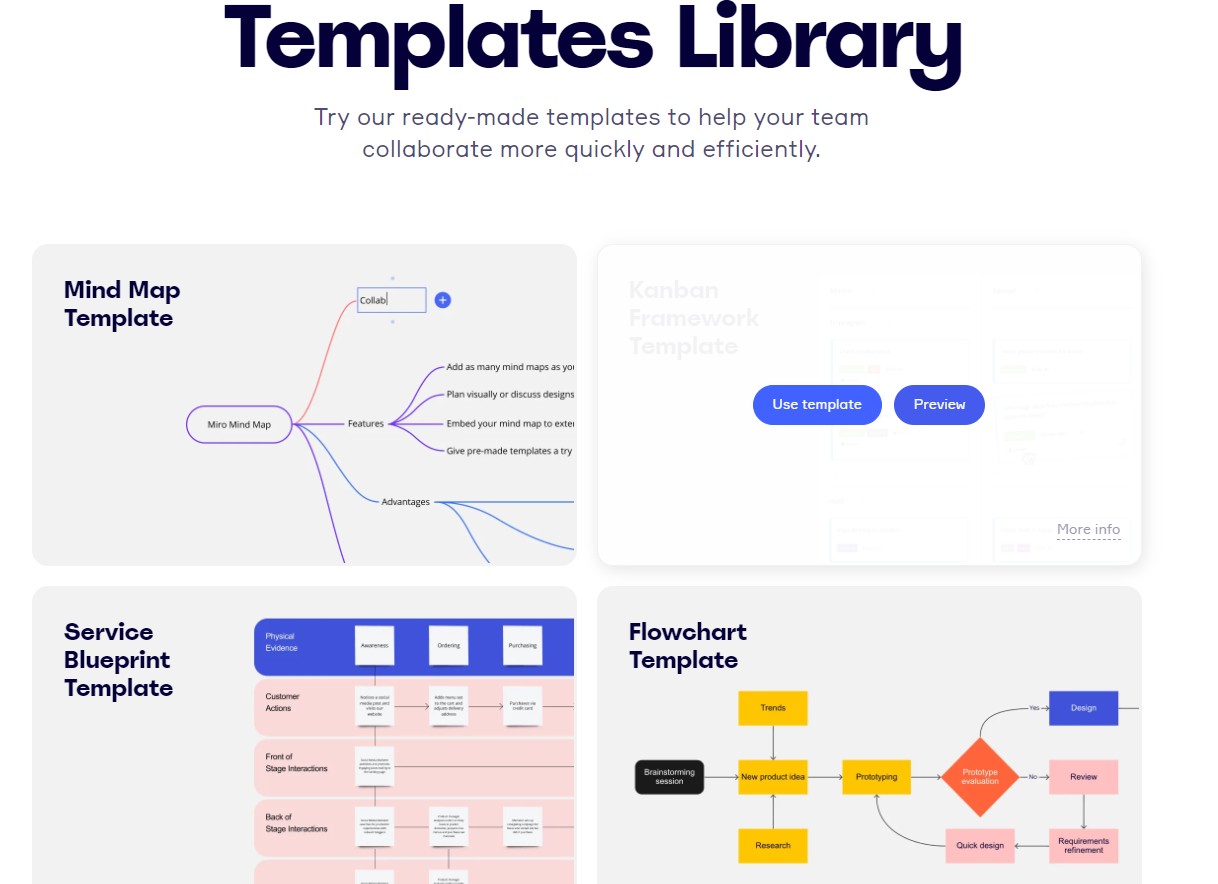

Image source: https://miro.com/templates/
Simplicity from the outset. No long-winded explanations about why each template is necessary for quick, efficient collaboration, just a snapshot of the template and the option to preview it or dive right in and use it. Remember: show, don’t tell.
Users who don’t immediately see the template they need, or want to select based on specific criteria like use case, team, or technique, simply hit the categories tab at the very top of the page. They’re greeted with a comprehensive dropdown menu of filtering options.


Image source: https://miro.com/templates/
The template subfolder represents over 25% of Miro’s organic traffic value ($283,000) despite only driving 10% of the organic traffic. To understand why, let’s take a look at their top page from this subfolder—the customer journey map template.
It’s the most visited page in Miro’s template arsenal, with an impressive search scorecard:
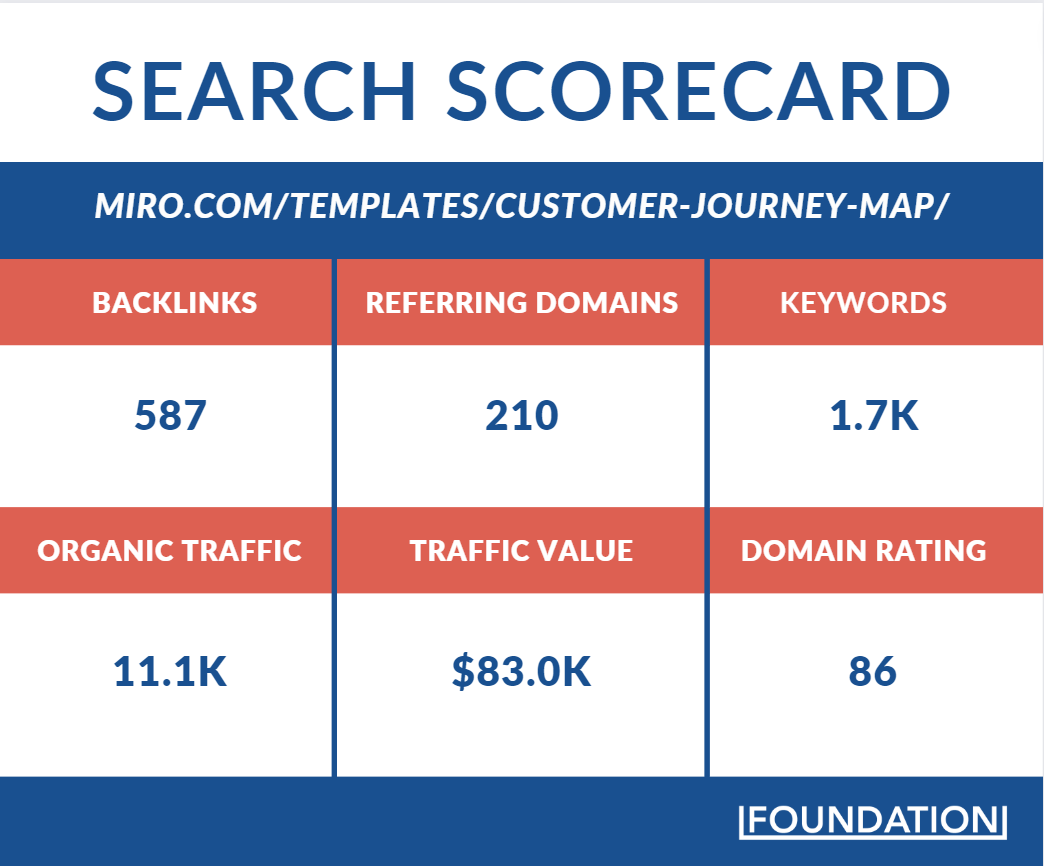

This template page single-handedly yields over 11,000 organic visitors each month from all across the globe. The keywords that this page ranks for all command a hefty CPC thanks to the search intent behind the topic itself. Why the high value? Because high-quality MQLs search for terms like “customer journey map template,” “customer journey map,” and “customer mapping template.”
Anyone who enters one of these phrases into a search engine is likely in charge of a team, department, or company that is looking to dive deep on their customer acquisition and all associated costs. This means they have a product, a company, and paying customers. Ipso facto, high-quality leads.
Miro’s remaining template traffic is spread more diffusely throughout 300+ templates, sortable by team, techniques, and use cases.
But excellent organic content isn’t the only reason Miro is dominating the exploding visual collaboration industry. They helped widen the gap between their competitors through a masterful rebranding campaign.
2nd Key: Rebrand and Realign with a Changing Work Culture
Miro’s branding is something to behold. What else would you expect from a brand whose namesake is the iconoclastic Spanish artist Joan Miró.
From the vibrant color scheme and graphics to the simple, powerful name, the company is positioned beautifully, aligning with the lofty goal of reshaping how the world thinks about work and creative potential in the hybrid-remote era.
But this is more than just a cherry on top for their marketing team. Miro’s branding helps them maintain their position at the head of the pack. Just look at their marketing channel breakdown:


Nearly 80% of Miro’s web traffic comes directly.
Even those who aren’t already active users are familiar with the name and know what they’ll get when they enter Miro.com into their browser. According to SimilarWeb, this type of direct traffic volume is a strong indicator of brand awareness and demand strength. Miro are masters of SaaS branding.
But this wasn’t always the case.
Here’s how a previous iteration of this online collaborative whiteboard platform looked in January of 2018:
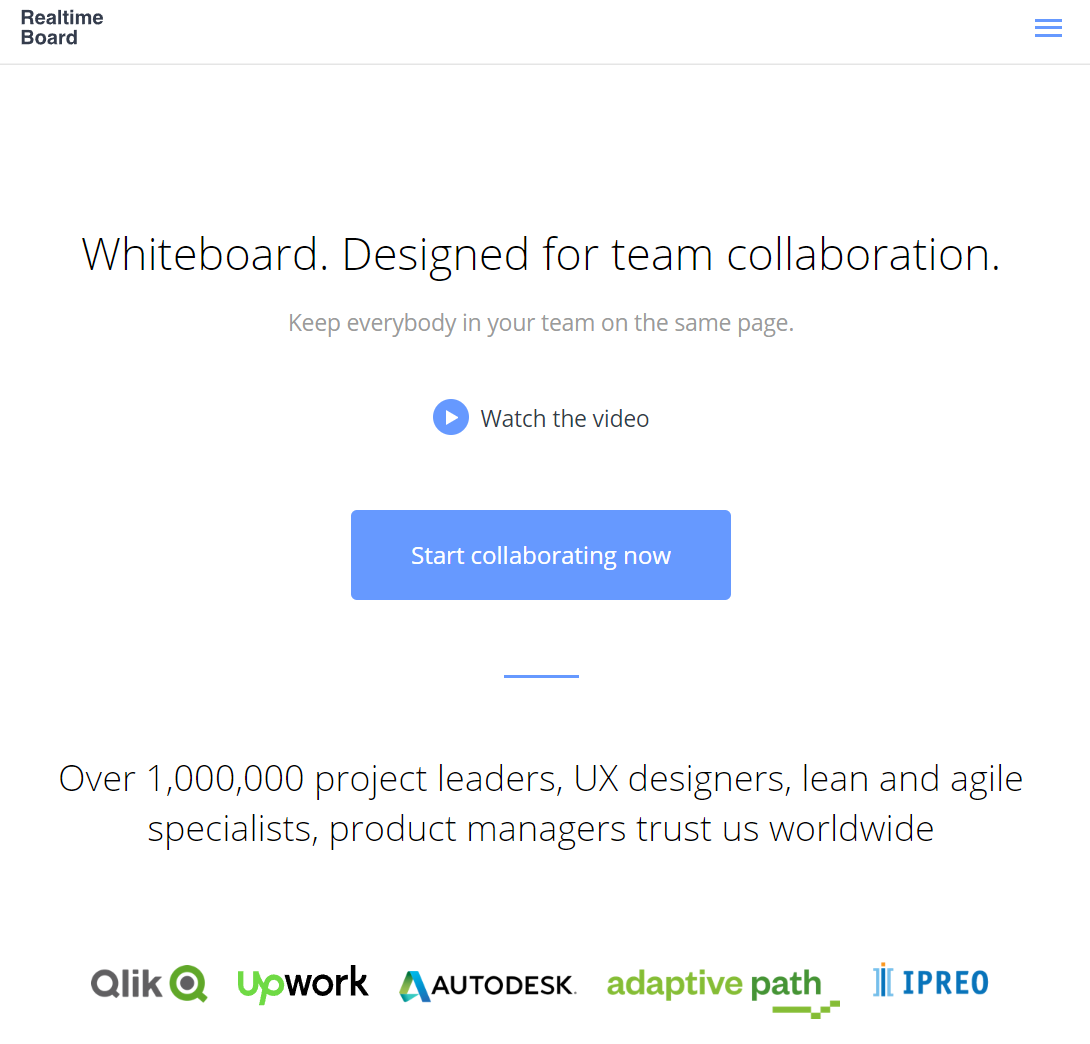

Image source: Internet Archive Wayback Machine
RealtimeBoard.
I know, it’s hard to think of a less creative name for a product that supposedly unlocks it.
Like the brand name itself, the homepage isn’t going to blow anyone away in terms of visuals or wording. Thankfully, the product itself was immensely popular among established enterprise companies. With social proof coming from major players like UpWork, Autodesk, and Ipreo (and millions of individual users), it’s fair to question whether a rebrand was even necessary.
If it ain’t broke, don’t fix it—right? Not when it comes to SaaS branding.
RealtimeBoard’s then-CMO, Barbara Gago, saw past the alluring initial success of the company to a great product in dire need of a compelling story. And finding the key issue didn’t take long—the name needed to go.
Here are three main reasons Gago gives as to why the company sorely needed to upgrade its name:
- Users, customers, and even internal team members were having difficulty keeping the name consistent, impacting their ability to grow through word-of-mouth.
- What the name gained in terms of communicating product value, it lost in impact due to the unwieldy length.
- No compelling story behind the brand, no ethos driving an emotional connection, no “why” behind the product’s existence.
To address these issues, RealtimeBoard conducted their own version of Google’s infamous 3-hour brand sprint (remotely, of course) to align their departments behind the company’s goal of offering “collaboration without constraints.” Gago also explains how Simon Sinek’s influential idea, Start with Why, is an indispensable resource for newer companies looking to solidify their brand identity and story.


Source: https://miro.com/blog/features/realtimeboard-is-now-miro/
What’s even more impressive is that they conducted this transition remotely over a period of just 3 months. Most companies take that long to simply vet the agencies they solicit for help. How did the soon-to-be Miro team accomplish this rebrand so quickly and to such great success? A few reasons come to mind for me:
- They already had the tools and expertise to execute creative collaboration because, well, it’s what they do.
- They unleashed the collaborative power of the remote-hybrid organization by distributing tasks both synchronously and asynchronously.
- They turned their own rebrand into the perfect case study / PR campaign for using collaborative whiteboards as a remote-hybrid, global enterprise.
For a (very, very) high-level glimpse into how their infinitely extensible product played a role in the rebranding process, take a look at the Miro board below:


Image source: https://miro.com/blog/features/rebranding-distributed-team-design-agency/
Here’s Miro’s former Head of Brand Experience Yegor Korobeynikov on how their product made this (re)brand sprint so successful:
“One of the reasons everything worked so smoothly was that we made Miro a central hub for our collaboration. It was the default app I’d open in the morning to leave comments and follow up after our discussions. It has the added benefit of making everything visible for all the stakeholders. Everyone who’s on a board can see it and follow its progression, unlike a Slack conversation that’s only visible to the people who are involved in it.”
Before writing off this change as an unnecessary expenditure for a company with big names on their client roster, it’s important to remember that plenty of other tech companies—MailChimp, Uber, and Adobe, for instance—deploy similar rebranding strategies. Although the reasons behind these strategies may differ, it’s clear that improving the qualitative side of SaaS messaging is key to unlocking the next level of growth. This is especially true when it comes to community building.
3rd Key: Turning the Website into a Global Community Hub
Miro is driving engagement with more than just strong content and revamped branding. This SaaS company has serious aspirations for a truly global presence—from its physical footprints in global metropolises like Amsterdam, San Francisco, and Tokyo to its thriving user communities in South America. One reason Miro has been able to achieve this global status is because its Notion–esque levels of popularity are from prioritizing community.
At just over 2 years old, the Miro community subdomain is another segment of the collaborative whiteboard company’s marketing strategy that is helping to set them apart from its competitors. The community subdomain isn’t blowing anyone away in terms of traffic value, but it brings in over 7,000 organic visits each month.


It’s a space for Miro enthusiasts to discuss any and everything relevant to the whiteboard that’s changing the game for remote-hybrid work. There’s a calendar for upcoming events, a leaderboard ranking active community members, a featured topics section, and a forum-like posting interface for easy navigation.
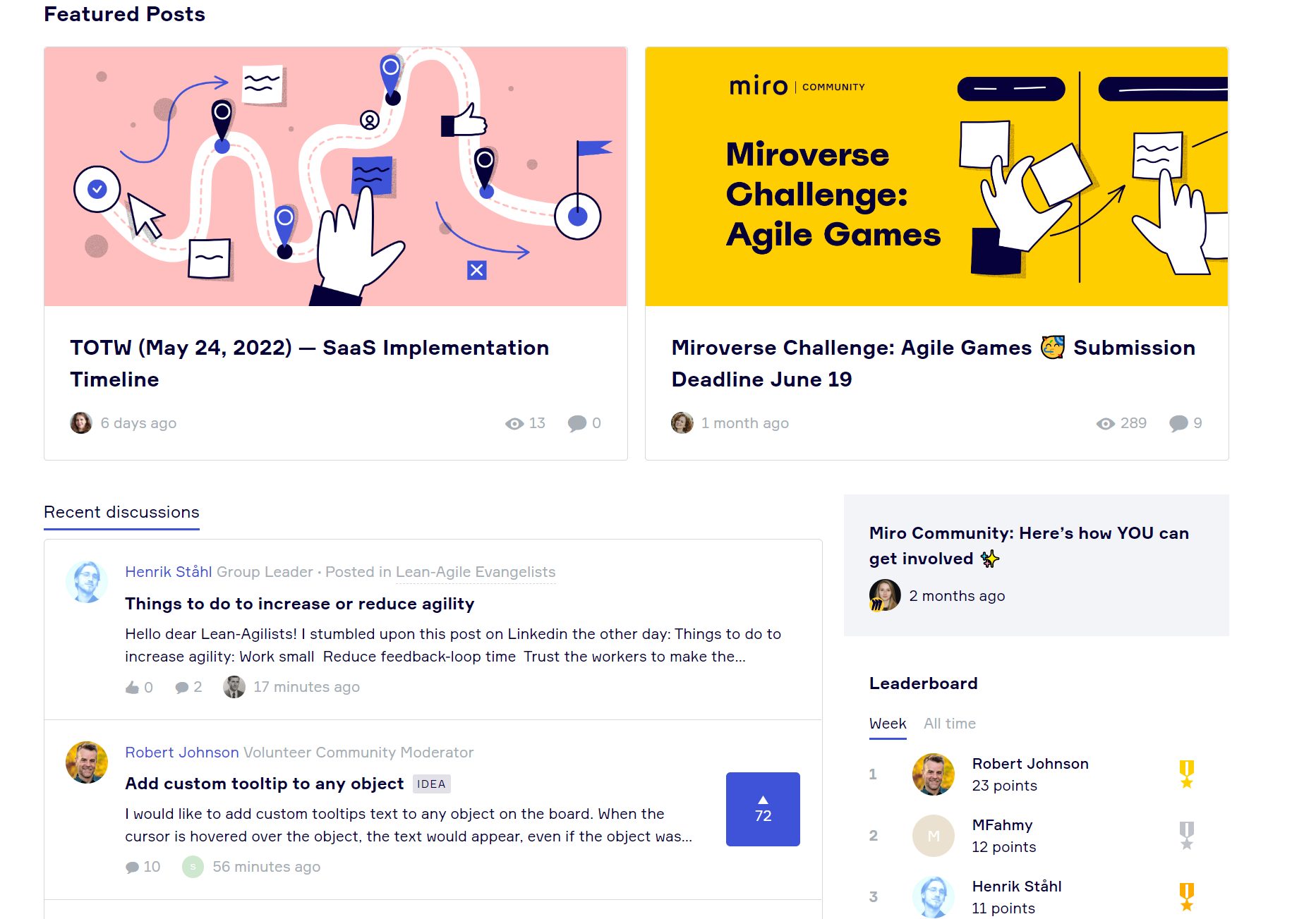

And if that doesn’t solve a user’s Miro-related question or concern, there’s another web-based solution waiting for them—The Miroverse.


Miroverse is a subfolder where Miro users can share “proven workflows, projects, and frameworks” with other members of the global community. This universe of creators comprises expert users, product evangelists, affiliates, and Miro community builders.
Just a few months ago, the Miroverse reached a major milestone in the form of its 1,000th community-generated template. That’s nearly 3 times as many templates as their official template sub-folder, all generated by Miro champions. And these champions can be found across numerous different industries.
In an example of Miro’s growing popularity in the education space, RMIT University lecturer Dr. Carla Amaral submitted a workshop planner to the global Miro community. Here’s how she views the collaborative whiteboard’s crowdsource-style platform:
“Miroverse is far more than simply templates. It is a destination for unique, community-driven contributions that help showcase the collective superpowers of Miro’s visual collaboration community. Miroverse is a helpful starting point for millions of people to be more successful in their own work.”
The success of both the Miroverse and Miro’s self-hosted community forum is a great example of the power that user-generated content represents in the B2B SaaS space. However, it’s far from a hands-off endeavor. According to LinkedIn, approximately 325 of their employees have a title involving Community. That’s over half as many as the 610 involving marketing and nearly 20% of their total employee headcount.
Community-building is an under-appreciated pillar of SaaS marketing. Product positioning and end-user content are important to building a winning brand, but they alone can’t push a brand into the upper echelons. Fostering community provides brands with an additional layer of content and strategic insights that benefit nearly every department within the company—not just marketing.
Product Sparks Growth—Content, Brand, and Community Sustain It
The pandemic and rise of remote work culture make the visual collaboration market a shining example of what is happening across many B2B SaaS niches: product excellence is the catalyst to overall success, but marketing is what captures and harnesses that energy for sustained growth. Regardless of the niche you are marketing to, your go-to-market strategy, or your product positioning, Miro’s success offers some great actionable insights:
1. Make Your Content an Extension of Your Product
Even if you aren’t following a “product-led” growth strategy per se, it always (always, always, always) pays to keep your end-user front and center for content marketing. It can be tempting to center your content towards the gatekeepers and executive stakeholders who hold the purse strings, but there’s really no better salesperson than a user who loves your product.
2. Don’t Forget Your Why: Keep Brand Alignment Front and Center
Miro may have already had 1M users and numerous enterprise-level clients at the time of their rebrand, but that doesn’t make it a waste of resources. User-centric content helps people find, use, and troubleshoot your content more easily, but without a strong brand and a definitive “why,” it’s difficult to sustain that growth. With RealtimeBoard, they won a million users. With Miro, they won the remote-hybrid community.
And that brings us to the final insight.
3. Bring Your Community Efforts In-House
The Miroverse is just over two years old and it’s already given Miro over 1,000 new templates and emboldened a global community of collaborative whiteboard enthusiasts. Best of all? They brought all this collaboration about collaboration directly to their web property. With the community subdomain and Miroverse subfolder, Miro is engaging its most active users and gaining valuable insights into its products, content, and overall brand.
The prospect of becoming one of the largest privately held companies seems like a pipe dream to many. Throw in a $17.5-billion valuation, 99% of the Fortune 100 as paying customers, and a mid-growth rebrand (not to forget a global pandemic) and this starts to sound ludicrous.
But remember: In terms of product ratings on G2 and Capterra, Miro is only holding a slim margin over their closest competitors.
They may be dominating the visual collaboration niche, but it’s not because they’ve unlocked some untapped product potential to win over an adjacent market.
It’s because they made a concerted effort to support their product with high-quality content, convert users into enthusiasts with a masterful rebrand, and actively empower those enthusiasts with a strong community.
The catalyst for dominance in a competitive industry is often found in the branding.
RealtimeBoard Miro is a prime example.
The B2B SaaS landscape is in the midst of another major upheaval. With many companies scaling back on their marketing efforts, forward-thinking companies have a perfect opportunity to expand their presence.
Quick, do it now before the next drop!







